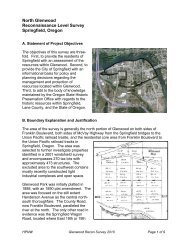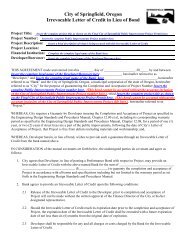WW Project Pages.xlsx - City of Springfield
WW Project Pages.xlsx - City of Springfield
WW Project Pages.xlsx - City of Springfield
You also want an ePaper? Increase the reach of your titles
YUMPU automatically turns print PDFs into web optimized ePapers that Google loves.
Another significant aspect <strong>of</strong> the funding scenario is the current imbalance between user fees and SDCsas sources <strong>of</strong> capital funding. <strong>City</strong> staff has documented that in many cases user fees are funding adisproportionate share <strong>of</strong> capital projects. Further, the economic downturn experienced in recent yearsled Council to defer significant portions <strong>of</strong> SDC increases that have been proposed based on updatedfacilities plans. Although the recommended SDC increases were fully implemented effective January 1,2011, the sluggish economic recovery continues to be reflected in a substantially reduced number <strong>of</strong>building permits and resultant SDC revenues. Until economic conditions and development activityimproves, existing users <strong>of</strong> the systems will continue to bear most <strong>of</strong> the costs associated withexpanding and upgrading those systems.For the 2012‐2016 CIP, a second source <strong>of</strong> concern is the projection <strong>of</strong> a continual decrease in fundingfor street preservation projects. State and local fuel tax revenues continue to decline because <strong>of</strong> thecurrent recession and increased fuel efficiency that reduces revenue even in the face <strong>of</strong> increased milestraveled. While the Council has increased storm drainage and local wastewater fees to maintain andenhance the level <strong>of</strong> preservation for those systems, the <strong>City</strong> no longer has the authority to increase itslocal fuel tax. While the State Legislature approved an increase in the State fuel tax that becameeffective on January 1, 2011, the <strong>City</strong> does not expect that the increased revenue it will receive from theState will be sufficient to reverse the trend <strong>of</strong> declining revenues to support the <strong>City</strong>’s transportationsystem.SYSTEMS DEVELOPMENT CHARGESThe second major source <strong>of</strong> capital funding is Systems Development Charges (SDCs). These are chargesimposed on development to provide funding to assure that the <strong>City</strong> can fund the cost <strong>of</strong> theinfrastructure needed to serve that level <strong>of</strong> development. There are several types <strong>of</strong> SDCs that can beused for capital projects. One <strong>of</strong> the SDC funds is the “Old” SDCs, which were funds collected under SDClaws in effect prior to 1991, and have different restrictions on use than the current SDC funds.These charges are calculated based upon a methodology which must be adopted by the Council andwhich must conform to State law. The process involves two separate components. The first is animprovement fee which is based on: a determination <strong>of</strong> which capital projects are needed toaccommodate growth, the amount <strong>of</strong> additional capacity that is created by those projects, and adetermination <strong>of</strong> the unit cost <strong>of</strong> additional capacity calculated by dividing the sum <strong>of</strong> project costs bythe sum <strong>of</strong> the capacity created. The second component, a reimbursement fee, is calculated bydetermining the value <strong>of</strong> the existing system, the amount <strong>of</strong> capacity available in that system, and thevalue <strong>of</strong> a unit <strong>of</strong> capacity. If the system has existing capacity, then development can be charged a feebased upon the units <strong>of</strong> existing capacity development will require. These charges are increasedannually based on documented increase in the Cost <strong>of</strong> Construction Index.Unfortunately, the facilities plans which are used to derive the projects to be constructed and thecapacity created by those projects (which dated from the 1970s), had been significantly out <strong>of</strong> date forboth local wastewater and storm drainage. As a result, fees collected were far below the amount,permissible under the statutes, which were needed to construct improvement projects. In 2008, the2012-2016 Capital Improvement Program Page 15
















